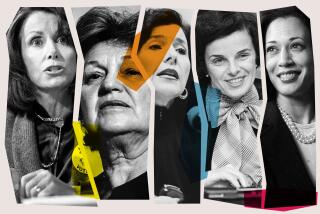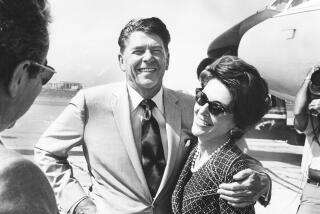First Lady’s 64th Birthday to Find Her More Popular
WASHINGTON — Nancy Reagan will greet her 64th birthday Saturday with much to celebrate.
She has been commended in a private audience with Pope John Paul II. She has been the subject of a one-hour television documentary. Her crusade against drugs, viewed early on as a transparent image-polishing exercise, has logged 70,000 miles and been widely credited with a national and international increase in parent participation in drug-abuse programs.
Once the least popular First Lady of modern times, Nancy Reagan is now even more popular than her husband, polls show.
“Everybody likes to be liked. It makes me very happy,” Mrs. Reagan said recently at the White House.
What is remarkable about Mrs. Reagan’s popularity is how far she has had to come to get it.
A Gallup poll conducted in December, 1981, showed that Mrs. Reagan had the highest disapproval rating, 26%, of any modern first lady, with an astonishing 61% saying she is less sympathetic than most first ladies to problems of the poor and underprivileged, and 62% feeling that she put too much emphasis on style and elegance during a time of federal budget cuts and economic hardship.
Mrs. Reagan was interviewed by The Times in 1982, after a series of criticisms that were dizzying in their diversity. She had spent $1 million in private donations on new china and a lavish redecoration of the White House living quarters at the same time her husband was cutting social programs and the country was plunging into a recession. She raised even more eyebrows by acknowledging that she owned “a tiny, little gun” and that she had accepted as gifts thousands of dollars worth of designer clothes.
It was after this first difficult year, and after Mrs. Reagan’s first official trip to visit a drug-rehabilitation center (undertaken 13 months after Reagan took office), that Mrs. Reagan was asked what she would like her legacy as First Lady to be.
“Oh, Lord,” she sighed.
“Oh, Lord,” she repeated, dismissing the possibility of talking about drug abuse.
‘I Tried’
She paused again and said that she would like people to remember “That I tried.”
No one in the Reagan Administration, least of all Mrs. Reagan, was prepared for the barbs that came her way. White House advisers even began to worry that she was becoming a symbol, according to White House pollster Richard Wirthlin, of the main objection to Reagan’s policies: that they favor the rich and are oblivious to the poor.
Mrs. Reagan was deeply hurt by the turn of events, “beaten down,” as she phrased it.
“I think a lesser person might have given up at that point and just faded into the background,” said Sheila Tate, who was Mrs. Reagan’s press secretary through most of the first term.
But Mrs. Reagan did not give up or fade. She fought back, fiercely.
“I think I’m strong,” Mrs. Reagan said when asked how she felt about her reputation for toughness. “I think you have to be strong. You couldn’t go through all this and not be.”
Along with what her son Ron describes as a “tough enemy” quality, shielding her husband from those who would “take advantage” of his never-say-no disposition, Mrs. Reagan also exudes an air of vulnerability, a desire for approval that her longtime friend, Nancy Reynolds, warmly refers to as “a lost little girl” way about her.
Yearning for approval in the White House, Mrs. Reagan embarked on her crusade against drugs and curtailed her public comments on her clothes, her wealthy friends and other controversial topics. She stopped accepting free clothes and did no more redecorating of the White House. In interviews with the press, she talked unrelentingly of drug abuse.
Polls suggest the formula has worked. A recent NBC news poll found that 69% of Americans approve of her and that a majority of women now think Mrs. Reagan “sets a good example for women.”
“I’ve never even thought about it,” Mrs. Reagan replied, when asked if she felt she had developed a stronger separate identity.
‘I Think I’ve Grown’
“I don’t think I’ve changed as a person, what values and so on that I have are still the same. I think I’ve grown. I certainly hope I’ve grown. I hope I’ve learned. . . . To not have your horizons expanded and your life become much fuller and more interesting (would be difficult). You have to grow in that sense, and it’s exciting.”
Mrs. Reagan has called her first year in the White House “a lost year,” due mostly to the assassination attempt on her husband.
“I realize now that things are much more magnified here in this position than I ever realized. Everybody is different and everybody does things their own way. My own way--and it was the same way in Sacramento, exactly the same way--my way is to come in and get my family, my home settled first. Once I do that, then I can move out and do whatever has to be done and whatever interests me.”
One of the people who helped her withstand the first year was a woman Mrs. Reagan had never met, but whom she admired and even, some say, patterned herself after: Jacqueline Onassis.
“She’s been very supportive,” Mrs. Reagan said. “During that first year, that was difficult and she knew it was difficult--everybody knew it was difficult--and the assassination attempt. . . . She would call and write. She’s very kind.”
Nancy Reynolds, a political consultant and lobbyist and one of Mrs. Reagan’s close friends, attributed much of Mrs. Reagan’s bad press the first year to “green-eyed envy” on the part of “these super-critical, super-feminist, young women reporters in their 20s and 30s. They see this great-looking woman who is in love with this man who adores her. Breathes there a woman who wouldn’t love to have the perfect relationship with a man? I think not.”
Former White House Deputy Chief of Staff Mike Deaver, who worked closely with Mrs. Reagan in the first term, also characterized early coverage of her as “unusually mean.”
But looking back on it all, Mrs. Reagan found fault on both sides.
“A lot of that whole interpreting me started before I ever got here,” she said. “I mean I can remember some articles that were written before I ever hit town. So there was kind of a feeling that was built up before I ever got here.
“Also, besides that, part of it was that I was no help, either. Because I, with all that went on that first year, which was a lot, if I get hurt or my feelings get hurt, then I tend to pull back, the wall comes down and I pull back. That’s not the right way to do it.
“But everybody has their own way. I think it’s probably a form of protection. You don’t want to get hurt any more. Then I got through that period and worked out of that, and then got into what I wanted to get into. I decided I couldn’t, I just couldn’t let this (criticism) dominate my whole life. I had to do what I was interested in, what I was concerned about.”
Mrs. Reagan said people like her better now not because she has changed but because “part of it was getting to know me.”
Drug-Abuse Campaign
When she took her initial public plunge into the drug-abuse cause, some questioned the sincerity of her concern, seeing it as an image-polishing ploy dreamed up by her aides. But Tate, who now works for a public relations firm, said recently that Mrs. Reagan “expressed an interest in drug abuse the first day I met her.”
As Mrs. Reagan travels the country visiting drug-abuse centers and parent groups, her message is always the same--that the solution lies in strengthening family ties and communication. She does not talk about how the issue has been handled in her own family with her children, Patti Davis, now 32, and Ron, now 27.
“They probably smoked marijuana, but not any more than that. They told me about it,” Mrs. Reagan said recently. “But they were never deeply involved.
“It was experimenting. I wish they hadn’t, certainly. I was very lucky because they were raised in the 1960s, which was a very difficult time for parents and children. . . . I was concerned with friends whose children were dying, committing suicide, jumping off buildings. (The children of) Art Linkletter, Ray Milland. Lots of them. Some of our friends’ kids that didn’t hit the papers.”
Her children’s experimentation with marijuana, she said, “was momentary. It was a very . . . it wasn’t that much of a deal. A very momentary thing.” She declined to say what she and her husband said to them at the time, saying, “You’re making more of it than was really there.”
Mrs. Reagan also is enjoying better relations with her stepchildren, Maureen and Michael Reagan. Michael Reagan had publicly complained that Reagan saw his grandchildren infrequently, a matter that was later smoothed over. Mrs. Reagan said there was “lots of exaggeration” about her reputedly frosty relationships with her stepchildren. She also disputes assumptions that the family is not close.
“We see them as often as we can. We talk on the phone a lot,” Mrs. Reagan said. “I think everybody got used to families with young children who were here, and I guess we’re the first ones to come along since Eisenhower with children who are grown, married, have their own lives, their own children, their own careers. People have gotten used to having young children at the White House. So the question was always, ‘Why aren’t your children here?’
“Well, they’re not children. Our children are not 16 years old. You couldn’t force them to live here. There comes a time when you have to let them live their own lives, as they should.”
Influence Exaggerated
There also has been a certain amount of exaggeration, she said, regarding how much she influences her husband’s decisions. She acknowledges that she keeps a close eye on personnel around the President. And when she sees something she doesn’t like--like the way his aides “overloaded” him before the first debate with 1984 challenger Walter F. Mondale--she makes her views known.
“I think everybody has their own strengths, and, if there’s a strength, I think mine is in the people area with him,” she said. “I think I’m more aware of the ones who are trying to end run him and use him.”
But she disputes claims that she advises her husband on policy matters.
Whatever she’s doing or not doing, deciding or not deciding, the public opinion polls suggest that people think she’s doing the right things.
Reminded of how she sighed in 1982 when asked about her legacy, and asked what her response would be now, she laughed.
“I might not sigh as much,” she said. “But it might still be, ‘I tried.’ ”
More to Read
Sign up for Essential California
The most important California stories and recommendations in your inbox every morning.
You may occasionally receive promotional content from the Los Angeles Times.










